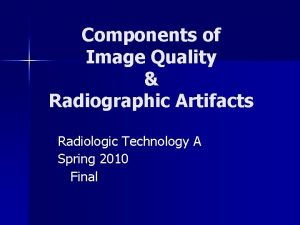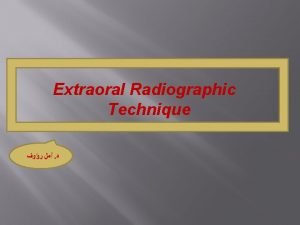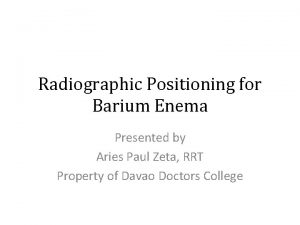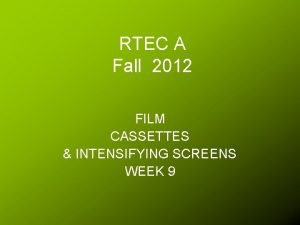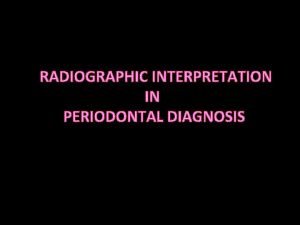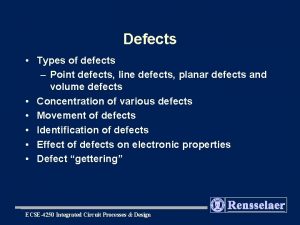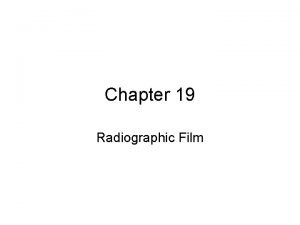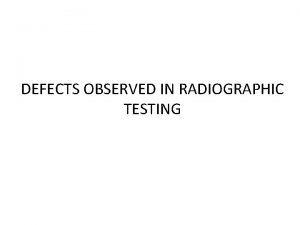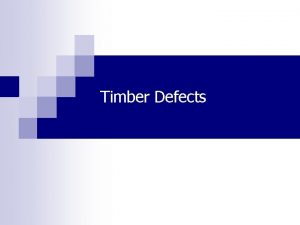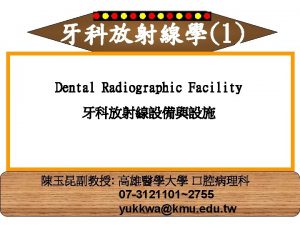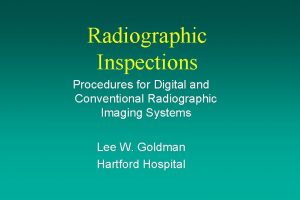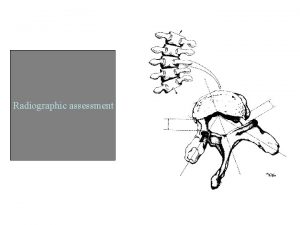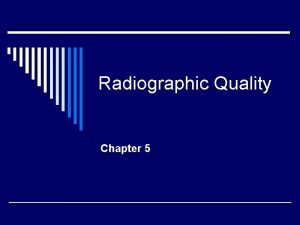ARTIFACTS OF XRAY RADIOGRAPHIC INTERPRETATION COMMON DEFECTS IN









- Slides: 9

ARTIFACTS OF X-RAY & RADIOGRAPHIC INTERPRETATION

COMMON DEFECTS IN X-RAY DEFECTS (1) Dark film (High density) (2) Weak image (Low density) (3) Faulty contrast High ('Soot and whitewash') - Low (Flat film) CAUSE (a) Over-exposure. (Reduce m. A-s factor. ) (b) Over-long development time. (C) Developer temperature too high. (d) Excessive fog (a) Under-exposure. (Increase k. V or m. A-s. ) (b) Developer time too short. (C) Developer temperature too low. (d) Developer exhausted. (e) Developer too diluted Insufficient penetration (k. V) of the dense portions of the subject. (a) High kilo voltage. (b) Incorrect processing. (c) Excessive fog

(4) Poor detail (Unsharpness) (a) Large focal spot. (b) Focal-film distance too short. (c) Part-film distance too long. (d) Uneven screen contact in cassette. (e) Movement of apparatus or patient during exposure. (f) Coarse stationary grid lines. (g) Large intensifying screen crystal size. (h) Poor film contrast (5) White scum (a) Crystallization of hypo due to insufficient Other scum washing. (b) Organic matter in water. (c) Grease. (6) Grid faults (a) Wrong focal-film distance which does (Areas of not correspond with the grid radius. peripheral (b) Off-centring from grid mid-line. underexposure) (c) Angling beam across the grid lines

(7) Fog Generalized fog Fog is an additional density unconnected with the primary image which reduces contrast and detail. (a) Prolonged storage. The shelf-life of a box of X-ray films is reduced when stored in warm, humid conditions, or in the presence of gases such as formaldehyde, ammonia or coal gas. (b) Chemical fog is caused by-development time too long, developer temperature too high, exhausted developer. (c) Radiation fog is caused by pre-exposure to ionizing radiations. (d) Excessive secondary radiation. (Use grid, small field and reduce k. V. ) (e) Exposure to light. Wrong filter in safe-light. Localized Light penetrating into cassette or film box. fogging at edges

(8) Stained films Colour (dichromic) fog Yellow stain. Due to insufficient rinsing or use of exhausted developer. (a) Prolonged development in old and exhausted solutions. (b) Developer temperature too high and causing oxidation. (c) Films sticking together in the fixer and lack of agitation Brown stain (a) Deposit of oxidized developer products. (b) Deposit of silver sulphide in fixer. Blue-green stain Exhausted chrome-alum fixer.

(9) Artifacts Streaking (a) Lack of agitation, especially in warm developer. (b) Dirty processing hangers. Dried-in fixer residue will contaminate subsequent films. (c) Insufficient rinsing. (d) Drying marks. Airbells (Clear white spots surrounded by a ring) Air bubbles on the surface of the film. (Avoid by occasional agitation of the film in the developer) Reticulation (Spidery, net-like markings of the film) Caused by extremes of temperature between processing solutions. Frilling (Loosening of film from the base) Hot processing solutions or high-temp emulsion drying. (It is minimized by the use of a hardener. )

Abrasion marks Long grey pressure lines caused by the film sliding across the floor when accidentally dropped. Static marks Exposure caused by the discharge of static (Arborescent black streaks) electricity. Can be caused when pulling a film out of a box without a folder, in a dry atmosphere. Developer splashes The splashes cause local prolonged development. (Dark black spots) Fixer splashes (White spots) Local reduction of the emulsion before development. Fingerprints (Dark or light) Handling of the film with dirty, greasy or contaminated hands.

RADIOGRAPHIC INTERPRETATION n • • • n 1 Location of lesion: There are 6 things on basis of which we can diagnose lesion. Size Architecture Contour (outline) Density Position Function 2 Classification of lesion: (1) Developmental (2) Metabolic (3) Traumatic (4) Infectious (5) Neoplastic (6) Degenerative

The following thumb rules should be followed during interpretation: • Eye should not be too close to radiograph particularly in examination of the abdomen & thorax. • For fine bone structures examination , eyes should too close to radiographic. • Use of spot light & lens for fine detail of structure.
